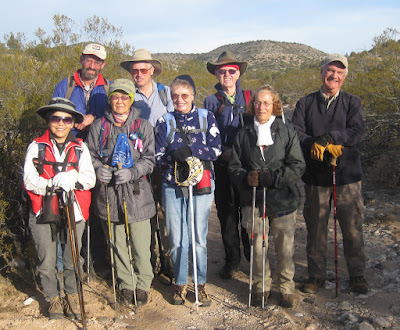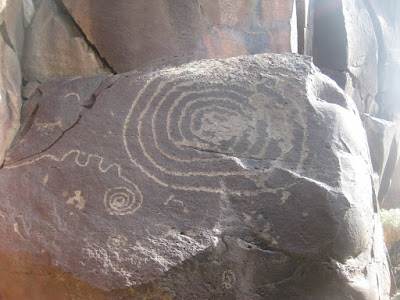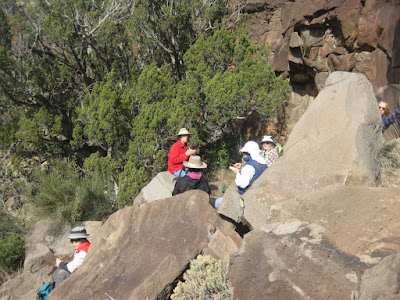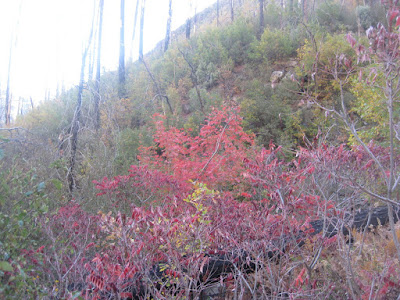The
08 December 2012 Skyliners hike was originally scheduled to be on the
dirt road that climbs to the Mogollon Rim between I-17 and Rarick
Canyon. That road, part of Beaver Creek Road, is called Blue Grade
because of the blue granite seen along the way. However, we decided
to change our schedule in order to visit a site further up Blue Grade
that has Indian drawings associated with the winter solstice later
this month. As a substitute for the originally scheduled hike, we
chose to start at the same location but cross Rarick Canyon and hike
a rocky, old road to the top of White Mesa. We would then return to
Rarick Canyon and visit Indian Petroglyphs located in Red Tank Draw
downstream from the crossing.
From
the I-17/Hwy 179 Interchange, we drove east on FR 618 for one-half
mile and turned left onto Beaver Creek Road (FR 689). We followed
this road for 1.3 miles, to just below where the blue grade starts,
and turned right onto FR 645A (referred to as White Mesa Road in this
report), followed it for one-half mile and then turned right to park
a short distance ahead near the rim of Red Tank Draw very close to
where some of the petroglyphs are located.
Red
Tank Draw is actually a smaller canyon formed by the stream flowing
out of the mouth of Rarick Canyon. It could just as easily be called
Lower Rarick Canyon.
Leaving
our cars, we headed along what we took to be FR 645A, expecting to
soon reach the Rarick Canyon crossing. Sadly, we failed to note that
we had actually turned off the real FR 645A, perhaps a hundred yards
before parking, and the road we followed ended at the stream in Red
Tank Draw after a quarter of a mile. Directly across the stream from
us was a sheer, red cliff, perhaps a hundred feet high.
One
of our hikers had been to this spot previously with another group of
hikers led by a person recognized as very knowledgeable about local
history. That person informed them that this had been a sheep
crossing. We saw galvanized metal bars firmly embedded in the cliff
wall, and we wondered whether this might have been part of some
structure designed to transport the sheep over the cliff. But that
seemed unlikely, as an easy crossing existed just a short distance
upstream where FR 645A crosses Rarick Canyon, and providing such an
expensive structure here for that purpose would seem to be quite
unnecessary. Later, viewing the area in Google Earth with a USGS
overlay, I found that this was the site of an old water gaging
station. This may, indeed, have been a sheep crossing, but the metal
structure had nothing to do with it, and the sheep would have had to
be herded either up or down the rocky streambed to reach a point
where it would be possible to climb out on the other side.
Sheep
crossing or not, this was obviously not the route we had intended to
take across Rarick Canyon, so we retraced our steps to where we had
parked and continued on past for a short distance to take the real FR
645A. Another short distance ahead, we encountered a large man-made
hump in the road that would stop all but high-clearance and
All-Terrain-Vehicles. The crossing itself, a little further ahead
ahead, would certainly have deterred other than ATVs or the most
dedicated of 4-wheelers. Despite all this, the route is marked on
the National Forest map as “open to all vehicles.”
 |
Rarick Canyon Crossing
|
Looking
back as we left the crossing behind us, we could see Blue Grade Road
snaking its way up the opposite side of Rarick Canyon.
 |
The black arrow points to Blue Grade Road
|
While
we were stopped to look at Blue Grade Road, we posed for a group
photograph.
 |
Left to right: Betty Wolters, Daisy Williams, Lila Wright, Dolly Yapp,
Kwi Johnson, the author, Becky Fowsky and Gary Jacobson
– photograph by the ninth hiker
|
White
Mesa Road was shaded by the Mesa as we headed up the rocky, old road
along its north slope. That made it pretty chilly on this December
morning, and we didn't stop for our morning snack until we came to an
isolated spot where the sun was peeking over the mesa. After a quick
snack, we hurried right along and were soon at the saddle where our
road topped out on White Mesa. We found ourselves at a fork in the
road, a fork that did not show on any of the maps I had referenced.
The right fork, the one not on the maps, led to the southwest,
apparently making its way to White Mesa Tank visible below us. The
left fork, which led higher on the mesa, was a continuation of FR
645A, the road we were following. After some thought, we took the
left fork so as to have a better view of our surroundings for our
lunch stop.
About
a hundred yards from the fork, our road became FR 644H while a very
faint road, FR 9248F, led off to the left, apparently to Rays Tank.
 |
Forest Road 644H
|
 |
Forest Road 9248F
|
Before
stopping for lunch, we continued straight ahead on FR 644H for about
another three-tenths of a mile to find a good viewpoint. We all
scattered out in the grass, each looking for a spot with a soft seat
and a good view. My selection was, of course, a nice patch of grass
that would suffice for my traditional noon nap.
From
our position high on White Mesa we had views in all directions. I
was particularly struck by the views west to the Black Hills and
northwest to the distant mountains beyond Sycamore Canyon.
 |
Looking across Verde Valley to the Black Hills
|
 |
Looking to the distant mountains beyond Sycamore Canyon
|
We
didn't linger on White Mesa very long after eating lunch because five
of us had decided to explore a future hike before returning home.
We
watched our footing carefully on the way back down and, even though
there were a number of near misses, no one took a spill. The section
shown in the below photograph exemplifies the treacherous hiking
surface that prevails along this stretch of White Mesa Road.
 |
Hikers stepping carefully along the rocky slope of White Mesa
|
The
trail was still shaded in spots on the way down, but the temperature
was just about perfect for hiking.
We
made it back to the crossing in short order, crossed to the other
side and continued along the road for about another tenth of a mile
before taking a faint trail to the left leading toward Red Tank Draw.
This trail runs for around 150 yards through catclaw to fade out
just short of the draw. From there, we just bushwhacked our way
until we were in the rocky streambed. Our goal was to follow the
stream down the draw until we came to the petroglyphs near where we
were parked. The blue line in the below graphic shows our route down
Red Tank Draw.
 |
Route down Red Tank Draw
|
The
going was rough down the draw, in some places there was water to be
avoided, in others it had seeped below the rocks and the streambed
was completely dry. In some places large pools had formed. All the
way it was very rocky. All-in-all, though, the trip was well worth
the effort. Late fall foliage was still clinging to the trees in
this sheltered environment and we soon started to see petroglyphs on
the canyon walls along the way.
 |
Fall foliage in Red Tank Draw
|
The
first petroglyphs we saw were located high on the left wall of the draw.
 |
The first petroglyphs we saw (magnified view)
|
After this, we saw
more and more of these as we progressed down the draw, predominately
along the left wall at first, but also on the right wall farther down
the draw. Additional examples are shown below.
 |
On the left wall
|
 |
Also along the left wall
|
 |
On the right wall
|
 |
Also on the right wall
|
The
last two examples, shown below, are located on the right cliff wall
where the trail leads up to where we were parked.
 |
On the way out of Red Tank Draw
|
 |
The last drawing as we left the draw
|
It was now after 1400
and, as previously noted, five of the party planned an additional
excursion to scout for a future hike. This would be a visit to a
site just off Blue Grade Road at the Mogollon Rim. We knew that
there were Indian solstice drawings there, just below the rim of
Rarick Canyon, and wanted to make sure we knew how to reach them
before scheduling an official hike.
We
all piled into Becky's hummer and drove up Blue Grade road for around
4.5 miles before turning right onto another road and going a further
three-tenths of a mile to park near what appeared to be a gravel pit.
The drawings were nearby and we found them after only one false
start, probably a new record for our scouting group.
The
GPS Track for this hike is shown on the included map (below).
The green line is the track we took to White Mesa, the yellow line
shows a section of the road to Rays Tank and blue line shows our
route down Red Tank Draw to look at petroglyphs. The round trip
distance for this hike was 4.8 miles, the maximum elevation was 4902
feet and the total ascent was 1183 feet. Our travels to scout out a
future hike are not shown.
 The
section of road shown in the photograph (right) exemplifies the condition of the road
along which we would hike all the way to the top of House Mountain.
Although it was a little rockier and a good bit steeper in places
than shown here. As
can be seen here, the road
was bathed in sunlight when we started our hike; however, that soon
changed, for the sun was blocked by a steep hill on our right as we
traveled deeper into the wash that would lead us up the mountain
toward our goal. The lack of sun coupled with a gentle, but chilly,
breeze that blew steadily at our backs caused us to move briskly
along in an effort to keep warm. As a result we made very good time
and an hour and a half from the time we started our hike we were at
Trick Tank (or as it is marked on my map, “Horse Mountain Trick
Tank”).
The
section of road shown in the photograph (right) exemplifies the condition of the road
along which we would hike all the way to the top of House Mountain.
Although it was a little rockier and a good bit steeper in places
than shown here. As
can be seen here, the road
was bathed in sunlight when we started our hike; however, that soon
changed, for the sun was blocked by a steep hill on our right as we
traveled deeper into the wash that would lead us up the mountain
toward our goal. The lack of sun coupled with a gentle, but chilly,
breeze that blew steadily at our backs caused us to move briskly
along in an effort to keep warm. As a result we made very good time
and an hour and a half from the time we started our hike we were at
Trick Tank (or as it is marked on my map, “Horse Mountain Trick
Tank”).
















































